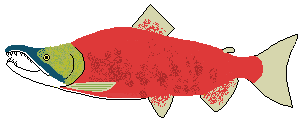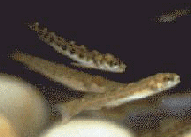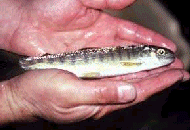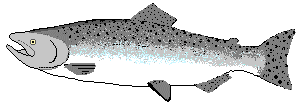
Trouts and salmon all belong to one large group, the Order Salmoniformes. They are often called "salmonids" because they belong in the Family Salmonidae. Members of this group are found around the world, not only in streams and rivers, but also in lakes and oceans. Salmonids tend to prefer cool temperatures; they can be found even in the Arctic Ocean.
The Salmonidae include "true" trouts such as rainbow, brown, cutthroat, Gila, Apache, and golden. Other fish that we also call trouts are not really, but are "chars," like the lake, bull, and brook trout, and Dolly Vardens. Whitefish, ciscos, and graylings are also salmonids. The "salmon" include chinook (king), coho (silver), chum (dog), pink, sockeye, kokanee, and Atlantic salmon.
"True" trouts and Pacific salmon have latin names that begin with the genus name Oncorhynchus, while brown trout and Atlantic salmon have the genus name Salmo. The chars have the genus name Salvelinus, and there are also the Coregonus (whitefish and ciscos).
Salmonids are considered to be a "primitive" fish: they developed earlier than most other fishes. They all have an adipose fin (a small, fatty fin between the dorsal fin and the tail), the function of which no one yet knows. They are all predators that eat other fish, and they all have a way of swimming that is called sub-carangiform; that is, they slowly wave most of the body in order to swim forward, with the head waving a little less than the posterior part of the body. Many of them migrate up streams and rivers to spawn and return downstream--to a lake or ocean--when they mature. Fishes that do this are called anadromous (an-AD-reh-mus), and include most salmon, some trouts, striped bass, sturgeon, lampreys, shad, and herring. (Eels are catadromous: they live in freshwater and migrate to the ocean to breed).
Rainbow trout are an anadromous salmonid. Rainbows are called "steelhead" when they are at sea even though they are still the same species, Oncorhynchus mykiss. Other trouts can be found in the ocean as well. Brook trout also often go to sea from northeastern North American streams, but return to their home streams in winter. Anadromous brown trout and brook trout (once believed to be the same species) are both called "sea trout" when they are at sea. Anadromous cutthroat (Oncorhynchus clarkii) are called "sea-run cutthroat" when at sea. Many Dolly Varden also turn anadromous.
Often, the main factor in whether trouts migrate to sea seems to be whether the coast is near enough to their home streams. Rainbow trout may be considered land-locked (they never go to sea). Most salmon go to sea, but "kokanee" are land-locked sockeye salmon (Oncorhynchus nerka). Adult kokanee are smaller than adult sockeye, and they spend their adult lives in lakes or streams instead of the ocean.
Salmonids that live in streams, such as trout, some chars, and very young salmon, tend to be more colorful and smaller in size than their ocean-faring cousins. Because they have smaller mouths, they eat smaller food. They begin small, with microscopic cladocerans and copepods, and build up as they grow to aquatic invertebrates like flies, worms, and fly nymphs. Eventually, they will be come so large that they are capable of eating other fish, including younger versions of themselves!
Many sea-going salmonids eat large amounts of shrimp-like copepods that have carotenoid pigments. These orange pigments will be transferred to their flesh. That is why some salmonids, like rainbows, chinook and coho salmon, and Atlantic salmon have such bright orange meat. Sockeye salmon also have an orange tint to their flesh, but when they begin their run upriver to spawn, the orange tint migrates to their skin. Thus their skin becomes bright red, while their flesh turns white. Chum salmon eat mostly jellyfish, and so as you might guess, their flesh is lighter colored--because jellyfish have no carotenoid pigments.
Salmon have a fascinating life-cycle. They start life in streams, migrate to the ocean to grow big and fat, and return to the same stream to spawn (to reproduce) and then die. Their deteriorating flesh then provides the nutrients that nourish their young when they hatch. There are exceptions, of course. We've already mentioned that kokanee go to lakes instead of the sea. Chum and pink hardly spend any time at all in their streams, while chinook and coho spend one or two years in them.
When adult salmon and anadromous trouts go to sea they turn a bright, silvery color to camoflage themselves from large predators. Trout that stay in their home streams remain colorful. When adult salmon return to their streams at the end of their lives to spawn, they stop eating and change into brightly colored animals, flashing red and often green. Spawning salmon, especially the males, change shape as well, developing large, vicious looking teeth, curved jaws, and humped backs. They somehow manage to find, most of the time, the very same stream they were spawned in so long ago. They endure many hardships--starvation, disease, and obstacles--to reach the shallow headwaters of their birth. Once there, they make nests in gravel nests (redds), deposit their eggs, fertilize them, and cover them back up. These salmon are now finished with their lives, and die.

Underneath the gravel, the large eggs receive oxygen from the water that runs between the rocks. When they hatch, the small fish, with yolks still attached to their bellies, are called alevin. The photo on the left shows two alevin and an egg. When the yolk sacs are gone, they will have to begin eating, so they leave the gravel as fry, shown in the middle photo. The young salmon will spend most of the rest of their time in the stream as parr, in the photo on the right. Salmon parr look almost alike, and species are hard to tell apart. Most of them are small, silvery, and have dark, vertical blotches down their sides.

Two alevins and an egg |
 Fry |
 Parr |
When it is time for the young salmon to go to sea, they will smoltify. That is, they will turn into smolts and become the silvery color that they will have in the ocean. They also change their body chemistry so that they can withstand exposure to saltwater. (When a fish lives in fresh water, it must work to retain enough salt in its blood. When it enters salt water, it must expel salt from its blood). They swim, taking the long, perilous journey downstream to the ocean.
Smolts must avoid birds like eagles, osprey, and kingfishers, and large fish, like squawfish and trout. They may find themselves trapped for too long in the high temperatures of a reservoir behind a dam, or suffer injury and death while trying to get through a dam.
When they finally reach the estuary--the place where river and ocean meet and their waters mingle--they will spend some time there, getting used to the saltwater, new food, and new predators. When they are ready, they will begin their sea voyage. Each run of salmon has its own destination, and some will go farther and range wider than others. All, however, will come home again.

To learn more about salmon, go to the Ecology page.

 Play a Watershed Game! Be an Explorer or a Detective!
Play a Watershed Game! Be an Explorer or a Detective!  Salmon and trout topics from King County, Washington.
Salmon and trout topics from King County, Washington.
 Salmon links
(Trouts are salmonids, too, so much of the information you will find here applies to trouts as well).
Salmon links
(Trouts are salmonids, too, so much of the information you will find here applies to trouts as well).
 To learn more about salmon, check out the reading list, where you will find some interesting references listed. (You will be able to order them from here, too!)
To learn more about salmon, check out the reading list, where you will find some interesting references listed. (You will be able to order them from here, too!)
 Return to Fishes
Return to Fishes
 Go back to Plants and Animals
Go back to Plants and Animals

| Site Search |
Today the salmons of America, especially the Pacific salmons, are being driven into extinction by over-fishing and loss of habitat. Most of the salmon now offered in stores has been grown on salmon farms. These farms look like docks attached to shorelines. The docks have "net pens" attached to them, in which the salmon live in crowded conditions. They are fed by hand with processed meal. Farmed salmon are raised much like chickens, in other words.
Since farmed salmon eat human-prepared meal, they tend to be relatively tasteless. Since they never get any exercise, their flesh is fatty and loose. Since they never eat crustaceans with orange and pink coloring, their flesh is gray rather than orange or pink. Fish marketers know that consumers would never buy gray salmon, so they dye the flesh orange.
So although the salmon you eat for dinner today may be greasy and tasteless, at least it will look authentic.
Salmon is good for humans due to its low levels of trans fatty acids and its high levels of omega-3 fatty acids. For all the strangeness of farmed salmon, it is very important that people buy and eat it rather than paying top dollar for wild-caught salmon. Wild salmon species are currently being driven to extinction by political influences that have led to over-fishing, hydroelectric dams, development, pollution, competition with hatchery fish, and climate change. Eating farmed salmon is a much more environmentally friendly way to enjoy salmon.
Salmo salar, Atlantic salmon: Atlantic species. Eats primarily squids, shrimps, and fish. This is the species most commonly farmed. Endangered species.
Salmo trutta, brown trout: A large European trout that is notoriously difficult to catch. Introduced to North America by humans in 1883, this trout has driven the more flavorful brook trout from much of its native range. It has also been introduced to Argentina where it has become anadromous and forms the basis of a popular tourist fishing industry.
Oncorhynchus tsawytscha, chinook salmon: Pacific species. Also known as "king salmon." Eat small fish. Endangered and threatened runs.
Oncorhynchus kisutch, coho salmon: Pacific species. Eat small fish. Threatened and endangered runs.
Oncorhynchus nerka, sockeye salmon: Pacific species. Landlocked variety called "kokanee." Primarily eat plankton, insects, and small crustaceans. Endangered and threatened runs.
Oncorhynchus keta, chum salmon: Pacific species. Also known as "dog salmon." Eat primarily jellyfish and plankton. Threatened species.
Oncorhynchus gorbuscha, pink salmon: Pacific species. Also known as "humpback salmon." Migrate up rivers every other year. Eat primarily plankton, insects, and small crustaceans.
Oncorhynchus mykiss, rainbow or steelhead trout: A trout native only to the Pacific Coast of North America. Now raised in hatcheries and introduced world-wide for sport fishing. An aggressive competitor. The rainbow is the land-locked version of the steelhead trout.
Oncorhynchus clarkii, cutthroat trout: A native trout found only west of the Rocky Mtns., and consisting of 10 subspecies. Most are threatened, some are endangered. Often hybridizes with introduced rainbow trout. There is a sea-run form.
Oncorhynchus gilae, Gila trout: An endangered species living only in the Gila River in Arizona/New Mexico.
Oncorhynchus apache, Apache trout: A threatened species living only in mountain streams in Arizona.
Oncorhynchus aguabonita, golden trout: A threatened trout with several subspecies, one of which is threatened. Native to California.
Salvelinus fontinalis, brook trout: Actually a char. A small, handsome, easy-to-catch trout native to the Great Lakes Region and NE United States, introduced to Western streams. Becomes anadromous ("sea trout") in northeastern North America.
Salvelinus malma, Dolly Varden: A large char closely related to the bull trout, and native to Pacific Coast states and Northeast Asia. May be found in marine waters as well as fresh water.
Salvelinus namaycush, lake trout: A large char found throughout the far north but never in saltwater. Nearly exterminated from the Great Lakes Region by the combined effects of overfishing, introduced fishes, and an intrusion into the great lakes by the sea lamprey, which was caused by human engineering.
Salvelinus confluentus, bull trout: An endangered char native to the West.
Coregonus clupeaformis, lake whitefish: Extremely popular foodfish. Schools with other whitefish in deep waters of Great Lakes.
Coregonus artedi, cisco or lake herring: Small, silvery fish that gathers into spawning schools in fall. An important part of lake trout's diet, as well as that of other large predator fish like pike.